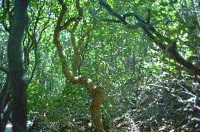|
Plant communities come about through a process of natural selection. Many species within a community will eventually create conditions unsuitable for their further growth, which results in the appearance of a new species which can take advantage of the new conditions. Thus the community changes until it ultimately may reach a climax stage--where the plants do not create conditions unfavorable to themselves. Most of the Sunken Forest has reached a climax stage characterized by American holly and sassafrass. Remnants of an earlier community of oak, pitch pine and red cedar are scattered here and there, but are mostly on the way out. The lack of dead holly trees suggests that the large ones are the first generation rather than replacements of earlier trees. The sassafras is a somewhat shorter-lived species and many of the older trees have died over the past few years. This process of succession leading to a climax stage can take thousands of years, but most likely took around 300 years in the Sunken Forest. Barring a large natural disturbance--such as a fire, hurricane, or human interference--the climax forest should persist for many years.
Learn More About Sunken Forest Vegetation Fire Island's Sunken Forest is a very rare ecological community. The Maritime Holly Forest is only found behind well-established sand dunes along the Atlantic coast from New Jersey to Massachusetts. It is one of six forest types recognized in the National Vegetation Classification System. According to the New York Natural Heritage Program, this state's maritime holly forest was ranked in 2001 as "globally rare" or "G1G2 S1" meaning there are few remaining occurrences of this assemblage of plants throughout the world. 
The maritime holly forest of Fire Island is dominated by American holly (Ilex opaca), some trees estimated to be up to 300 years old. Other trees in this forest canopy include the sassafras (Sassafras albidum), shadbush or serviceberry (Amelanchier canadensis), and other hardwoods that are able to develop behind tall secondary dunes. The black oak (Quercus velutina), post oak (Quercus stellata), black cherry (Prunus serotina), and pitch pine (Pinus rigida) may be seen in the Sunken Forest, although none of these trees will grow higher than the dunes that protect them. A fully mature oak may be no more than 25 feet high when exposed to harsh maritime conditions. In low depressions where fresh water can accumulate, bog species may grow. Red maple (Acer rubrum), blackgum (Nyssa sylvatica), blueberry (Vaccinium sp.) and other shrubs, and sphagnum moss and ferns are also found in the Sunken Forest. Vines are particularly abundant and add to the mystique of the Sunken Forest. Wild grapes (Vitis spp.), greenbriar (Smilax rotundifolia), Virginia creeper (Parthenocissus quinquefolia), and poison ivy (Toxicodendron radicans) are common. In addition to providing cover, their fruits provide food for a variety of birds and other wildlife that may be seen in the Sunken Forest.
The shrub layer of the Sunken Forest includes saplings of species in the tree layer, usually American holly (Ilex opaca), blackgum (Nyssa sylvatica), black cherry (Prunus serotina), and serviceberry (Amelanchier canadensis). Shrubs of bayberry (Myrica pensylvanica), highbush blueberry (Vaccinium corymbosum), black huckleberry (Gaylussacia baccata) and inkberry (Ilex glabra) may be seen but are less common. The herbaceous layer is now poorly developed, and is characterized by Pennsylvania sedge (Carex pensylvanica), with starflower (Trientalis borealis) and Canada mayflower (Maianthemum canadense) as occasional associates in the spring. Historical studies of the vegetation of the Sunken Forest has revealed a substantial change in the composition of the shrub and herb layers since 1967, when huckleberry (Gaylussacia baccata) and blueberry (Vaccinium corymbosum) were regular associates of the shrub layer and wild sarsasparilla (Aralia nudicaulis), starry false solomon's seal (Smilacina stellata), brackenfern (Pteridium aquilinum), starflower (Trientalis borealis), Canada mayflower (Maianthemum canadense), herb robert (Geranium robertianum) and pink ladies slipper (Cypripedium acaule) were frequent associates of the herbaceous layer. These changes may be attributable to heavy deer browse as a result of the increase in the deer population in recent decades (Art 1987, Art 1992).
|
Last updated: March 31, 2012
